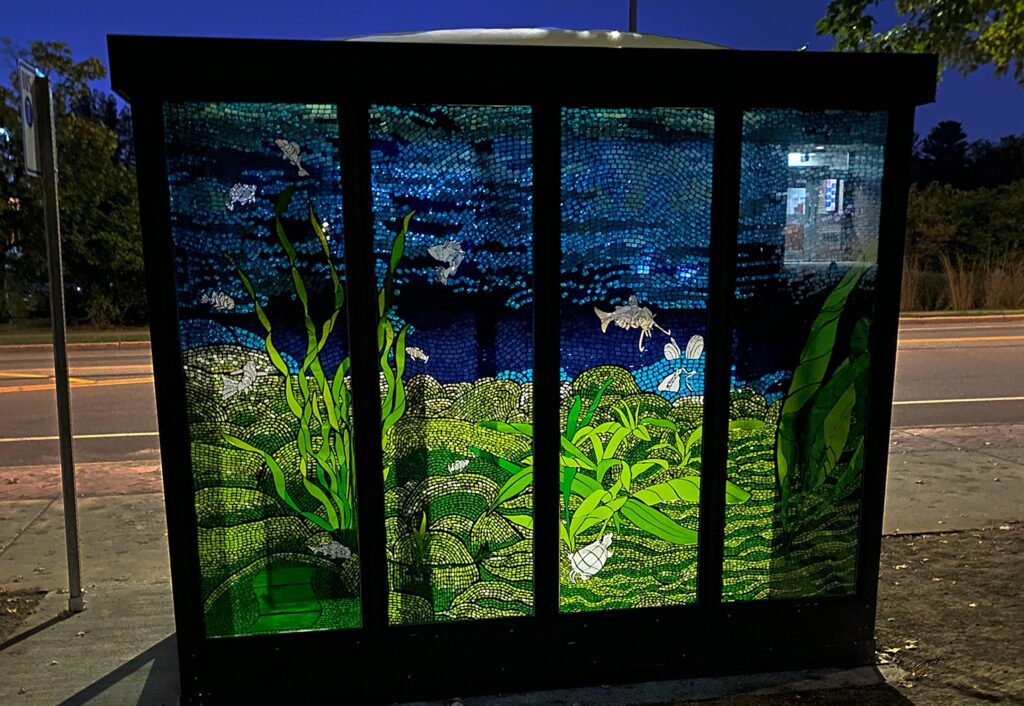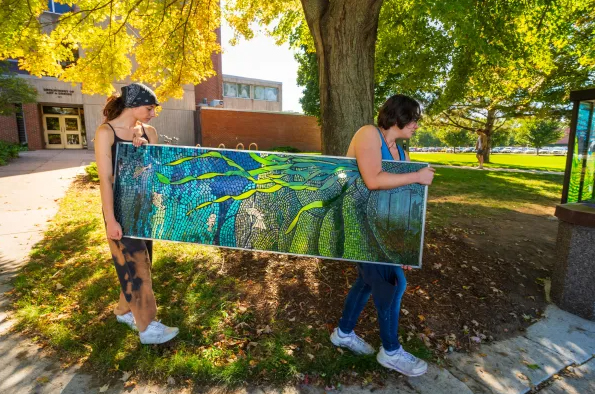
A six-panel, stained-glass mosaic designed by a professor of art and fabricated by art students adorns a bus stop on the UW-Eau Claire campus. The subaquatic scene features a variety of fish and plants, some of which are endangered species.
The historic Water Street portion of the University of Wisconsin-Eau Claire campus near the Haas Fine Arts Center has a new public art installation that beautifies a bus stop while educating riders and passersby about the subaquatic life of the nearby Chippewa River.
The six-panel, stained-glass mosaic enclosure was designed by Jyl Kelley, professor of art, and fabricated by art students Theron Christiansen, Erin Phelps and Anmarie “Rie” Roos.
The subaquatic scene represents the Chippewa River and features a variety of fish and plants, some of which are endangered species, Kelley says.
“This design brings attention to endangered species in our river and also gives viewers a perspective of what it might be like to look under the surface of the water,” Kelley says.
The state Department of Natural Resources provided input about local endangered aquatic species depicted in the mosaic, Kelley says, while Dr. Doug Faulkner, professor of geography, offered information to inform the design of the riverbed the scene represents.
The project was sponsored by the Eau Claire Transit Authority, the city of Eau Claire, the UW-Eau Claire Student Office of Sustainability, the Office of Research and Sponsored Programs and the department of art & design. Instrumental assistance in the installation process was provided by Jacoby Matott, UW-Eau Claire wood and metals shop supervisor.
A reception celebrating the mosaic installation will be at the bus stop structure from 11:30 a.m.-12:30 p.m. on Monday, Oct. 7.
Our goal was to beautify the bus stop space and also offer the bus stop riders and general public an opportunity to connect with their natural surroundings. The river theme is relevant to its Water Street location. –Jyl Kelley, professor of art
Created by Blugolds to last a generation
For the three students who created the glass panels, Kelley was excited to offer an avenue of artistic expression that was both unique and challenging. Over the course of the project, the three students graduated in 2024 and recently completed the installation of the panels as Blugold alumni.
“Working with stained glass material has been an excellent challenge that has offered many new learning opportunities for our group since glass is not a medium that is traditionally offered in our department,” says Kelley, adding that the artists had to account for how the light passing through the glass affects the environment for viewers both inside and outside of the bus stop.
For Roos, the project presented a significant learning curve in developing new skills in this medium, as well as a chance to take part in creating public art.
“There was a lot to learn in cutting the glass,” says Roos, who graduated with a graphic communications degree. “Getting specific shaped pieces for the fish didn’t always turn out like we wanted, as the glass liked to break straight so trying to get good curves that wouldn’t shatter was a challenge.

